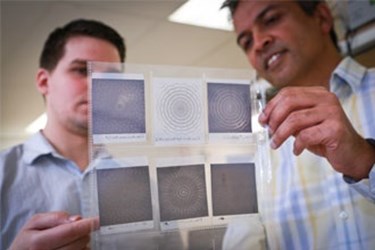Printable Filters Manage THz Communications

Plasmonic filters created with an off-the-shelf inkjet printer could enable blazing-fast wireless downloads and clearer cellphone calls using the terahertz spectrum.
University of Utah researchers developed the filters, which are created with silver-metal ink similar to what is used for the production of circuit boards and tiny antennas.
By filtering out unwanted frequencies, users can download information from the Internet or talk on a cellphone, for example, with less noise or interfering signals.
Terahertz technology has the potential to send data back and forth at terabits per second. Filters will be a vital components in terahertz communications networks because it will be necessary to separate frequencies in order to create multiple channels. Many wireless devices use filters to single out frequencies, including Wi-Fi routers, televisions and cellphones.
“Your cellphone operates at a frequency of 2.4 GHz. A terahertz is a thousand gigahertz,” said graduate student Andrew Paulsen. “If we could effectively use the terahertz spectrum for communications, we could have a thousand times more bandwidth than we currently do.”
The researchers said it might be another 10 years before consumers are using Wi-Fi routers or cellphones with terahertz technology, but communications companies could use it for their network backbones much sooner.
A current limitation of terahertz frequencies is that they require line of sight and can transmit only over short distances. But some researchers have already achieved fast download speeds with wireless terahertz chips, and others are interested in broadcasting 4K television signals over the air with cameras that use the terahertz spectrum.
“Terahertz technology is something there is a lot of interest in,” said professor Dr. Ajay Nahata. “I guarantee that people will come up with new ideas that can use all of that available bandwidth.”
Terahertz radiation, or T-rays, can also pass through many materials without causing ionization, which makes the spectrum attractive for use in medical imaging and security screening devices.
For more information, visit www.utah.edu.
Source: The University Of Utah
